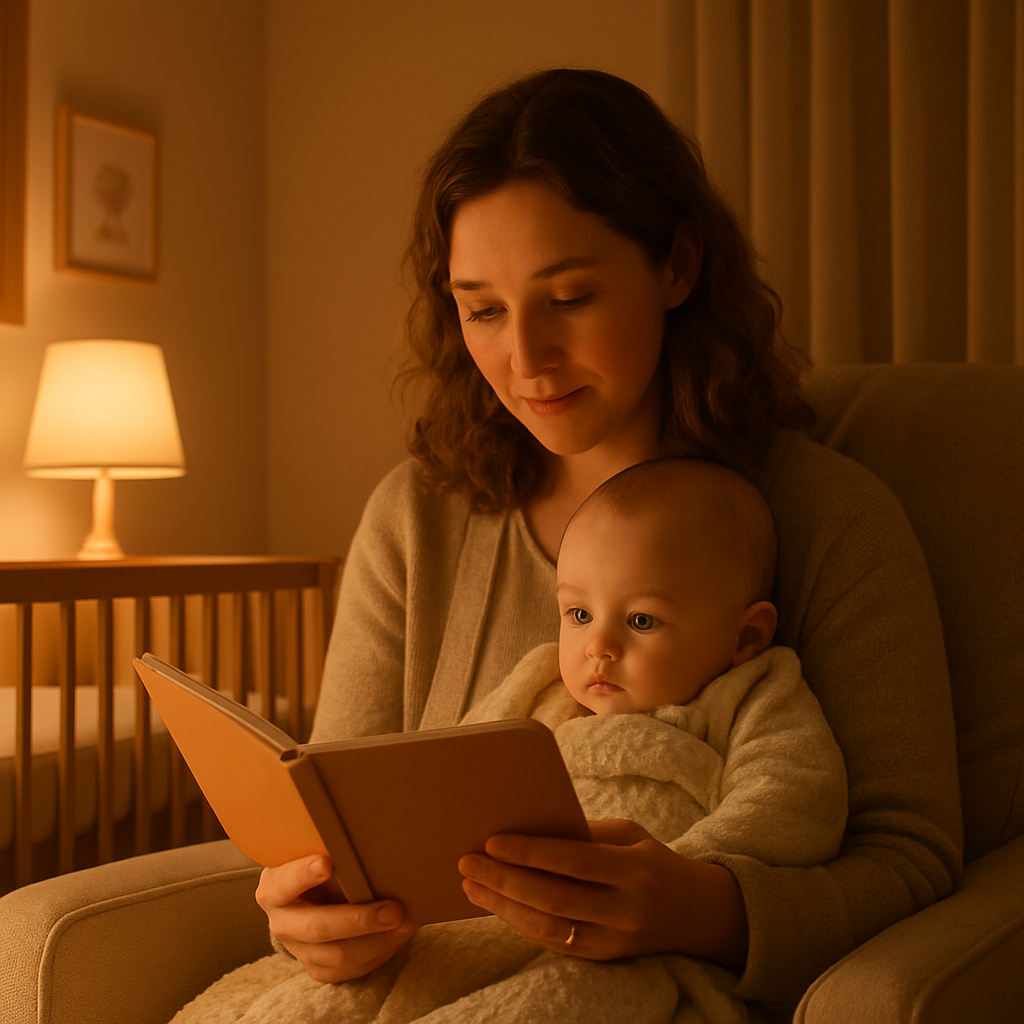Research suggests that babies who sleep just 30 minutes longer each night may show up to 20% more white-matter growth by age one, enhancing neural pathways critical for language, problem-solving, and emotional regulation. Yet, with shifting wake windows, cultural myths, and busy schedules, crafting a science-backed bedtime routine can feel daunting. This guide translates cutting-edge neuroscience into a practical, adaptable ritual you can start tonight—turning every cuddle, story, and dimmed light into a foundation for lifelong learning.
- Why does a consistent sleep routine supercharge your baby’s developing brain?
- How much sleep does your baby need at each age?
- What core steps build a brain-boosting bedtime routine?
- How can you tailor the routine to your baby’s cues and your family culture?
- Which common baby-sleep myths sabotage brain-friendly rest?
- How do safe-sleep practices fit into your nightly routine?
- What tweaks help during growth spurts, illnesses, or so-called regressions?
- How can you measure progress and adjust the routine over time?
- Your Top Questions, Answered
- Final Thoughts
Why does a consistent sleep routine supercharge your baby’s developing brain?
A predictable bedtime routine signals the brain to shift from alertness to repair mode, optimizing deep non-REM and active REM sleep phases. During these stages, the brain prunes synapses, myelinated white matter for faster nerve conduction, and consolidates memories—processes that underpin language acquisition and self-regulation. A 2015 study found that families maintaining a routine at least four nights weekly saw longer sleep durations and, by age five, children with richer vocabularies. Nighttime sleep particularly supports language development, while daytime naps enhance short-term memory, as explored in Why Naps Boost Your Baby’s Memory.
Key Benefits of Routine Sleep:
- Enhances white-matter growth, potentially by 20% with extra sleep.
- Strengthens neural circuits for language and executive function.
- Promotes emotional security through predictable caregiver interactions.

How much sleep does your baby need at each age?
Sleep needs vary by age and individual biology. The table below provides evidence-based ranges. You can always adjust to your baby’s unique cues, such as yawning or fussiness, rather than strictly following the clock as per (Sleep-Related Infant Deaths).
| Age | Total Sleep per 24 Hours | Typical Wake Window |
|---|---|---|
| 0–3 months | 14–17 h (normal 11–19 h) | 35–90 min |
| 4–6 months | 12–15 h | 1.5–2.5 h |
| 7–12 months | 12–15 h | 2–4 h (think “2-3-4” guide) |
| 13–24 months | 11–14 h | 4–6 h |
Melatonin production in toddlers often begins around 7:40 pm / 19:40, later than many schedules assume, so forcing an early bedtime can backfire. For a full age chart, visit Baby Sleep Needs by Age.
What core steps build a brain-boosting bedtime routine?
A science-backed routine rests on three pillars: a calm environment, a predictable sequence, and positive parent interaction. Here’s how to implement them:
- Create a Low-Stimulation Space: Dim lights to 10–50 lux, maintain a cool room (68–72°F / 20–22°C), and use white noise to mask disruptions. These conditions signal the brain to produce melatonin, easing sleep onset.
- Follow a 20–40-Minute Sequence: Try a warm bath → 5-minute massage with unscented lotion → pajamas → short board book → lullaby. Consistency reinforces neural expectations, reducing bedtime resistance.
- End with Connection: Offer gentle rocking or skin-to-skin cuddling. Lay your baby down drowsy but awake to foster self-soothing skills, which support long-term sleep independence as per Safe Sleep Guidelines.
Avoid screens, rough play, or sugary feeds within an hour of bedtime, as blue light and adrenaline can delay melatonin release by up to 90 minutes. For more tips, see How Sleep Boosts Your Baby’s Brain.

How can you tailor the routine to your baby’s cues and your family culture?
Watch for early sleepy signs—slower blinks, ear tugs, or glazed eyes—and begin the routine within 10–15 minutes to prevent overtiredness. Responsive timing outperforms rigid schedules, especially in households with shift work or multiple caregivers.
Cultural practices also shape routines. Mediterranean families often embrace later bedtimes, while many Asian households practice safe bed-sharing, both compatible with healthy development. Explore benefits and precautions in Co-Sleeping vs. Crib.
Adapt with these practical solutions:
- Use blackout curtains in urban or crowded homes to block light.
- Invest in a $30 white-noise machine to muffle city noise or household chatter.
- Pack a travel-size routine kit (pajamas, small book, lavender wipe) for consistency at grandparents’ or daycare.
Which common baby-sleep myths sabotage brain-friendly rest?
Misconceptions can derail effective routines. Here are three debunked myths:
-
Myth: “Babies must sleep through the night by 3 months.”
Fact: Night wakings are normal, protecting against SIDS and supporting growth spurts. See SIDS Research. -
Myth: “Sleep regressions hit every baby at set ages.”
Fact: Variability is common; regressions may occur at 4, 8, or 12 months but aren’t universal. Check Baby Sleep Regressions. -
Myth: “Strict schedules make babies smarter.”
Fact: Consistency, not rigidity, drives benefits. Emotional security and total sleep hours outweigh exact bedtimes.
How do safe-sleep practices fit into your nightly routine?
Safe sleep is non-negotiable for brain health and safety. Always place your baby on their back on a firm, flat surface—crib, bassinet, or play yard—with no loose bedding or toys as per Safe Sleep Guidelines. Room-share for the first 6–12 months to monitor breathing without compromising independence. Complete cuddles in a chair, then transfer your baby to the crib while slightly awake to reinforce it as a safe sleep zone.
Review full guidelines in Safe Sleep Practices for a Healthier Baby Brain.

What tweaks help during growth spurts, illnesses, or so-called regressions?
During disruptions, maintain two or three core routine elements, like a lullaby or massage, to preserve familiarity. Adjust bedtime by ±30 minutes to avoid overtiredness, offer extra feeds during growth spurts, and use a humidifier for congestion. Daytime motor activities, like crawling practice, can reduce nighttime restlessness. For balancing independence and comfort, see Sleep Training vs. Night Wakings.
How can you measure progress and adjust the routine over time?
Track three metrics weekly: time to fall asleep (sleep latency), total nightly sleep, and next-day mood. A sleep latency under 15 minutes and cheerful mornings signal success. Red flags—chronic sleep under 10 hours, loud snoring, or breathing pauses—require a pediatric check Overtired Baby?. Gradually extend wake windows by 15 minutes every few weeks after six months to align with maturing circadian rhythms.
Your Top Questions, Answered
-
When should we start a bedtime routine?
As early as two weeks. Babies recognize patterns by 8–12 weeks, and early routines ease later transitions. -
Is melatonin safe for infants?
Not recommended. Behavioral cues and environmental tweaks outperform supplements; use only under medical guidance due to limited infant safety data. -
How long before we see improvement?
Three to seven nights of consistent cues often shorten sleep onset; brain benefits, like enhanced language skills, accrue over months. -
Where can I learn more about sleep’s impact on brain growth?
Explore How Sleep Boosts Your Baby’s Brain for deeper science and strategies.
Final Thoughts
A calm, predictable bedtime ritual is more than a path to quiet evenings—it’s a scaffold for neural growth, language development, and emotional resilience. By weaving science-backed steps into your nightly routine, you transform ordinary moments into lifelong gifts. Enjoy the peace, and know you’re nurturing brilliance as your baby dreams.